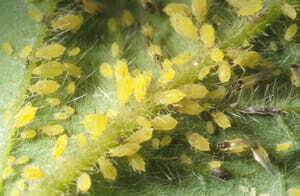
Soybean aphids can reduce yield by 10 to 15%. The insect is found in soybeans between May and August and are less than 1/16 inches long. Aphids have yellow bodies with a translucent appearance and may be winged or wingless.
Unlike other soybean insects, female aphids can produce clones and can multiply the insect population during the summer months. With the rapid reproduction abilities of female aphids, it is possible for populations to double in as little as two to three days. Males typically do not appear for mating until the late summer.
Apart from reproduction, environmental conditions that fuel infestation can also lead to a rapid increase in aphid populations. Temperatures between 72 and 77° and humidity below 78% drive the development of aphids. Drought conditions also make soybeans more susceptible to infestation.
Implications for Yield
Yield loss from aphids is attributed to the damage caused from feeding on leaves. Their destructive leaf feeding can reduce plant vigor and overall stand along with pod and seed populations.
Aside from feeding damage, waste produced from aphid feeding can leave a soot-like mold on the surface of leaves and reduce photosynthetic leaf area.
Scouting for Aphids
Aphids are most often found on the backside of the newest leaves, especially during the earliest part of the summer when the insect first emerges. Sampling for aphids should begin once the first signs of the insect are spotted. It is recommended to sample 20 to 30 plants across many areas of the field.
As the insect population increases, aphids can begin to inhabit the entire leaf canopy. If aphids are spotted on stems, this is a sign that aphid populations are above 400 insects per plant – an amount considered to be excessive. Be sure to scout for symptoms at least every 7-10 days until R6.
Management
Treatment of soybean aphids is advised if more than 80% of plants are infested and counts are in excess of 250 aphids per plant. Also, if it is evident that the population of the insect is increasing, this is also grounds for beginning treatment.
Foliar insecticides are the best method for combatting aphid populations in soybeans. In addition, biological control plays a role in staving off high aphid populations including pirate bugs and Asian ladybird beetles. When assessing the best treatment options for soybean aphids, be sure to consult with your local Latham representative.
